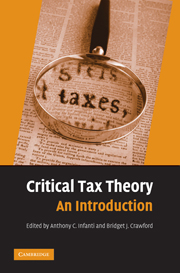Book contents
- Frontmatter
- Contents
- List of Illustrations
- List of Tables
- List of Contributors
- List of Common Abbreviations
- Introduction
- CHAPTER 1 FOUNDATIONS OF CRITICAL TAX THEORY
- CHAPTER 2 HISTORICAL PERSPECTIVES ON TAXATION
- CHAPTER 3 THE GOALS OF TAX POLICY
- CHAPTER 4 CRITICAL TAX THEORY MEETS PRACTICE
- CHAPTER 5 RACE AND TAXATION
- CHAPTER 6 GENDER AND TAXATION
- CHAPTER 7 SEXUAL ORIENTATION AND TAXATION
- CHAPTER 8 THE FAMILY AND TAXATION
- Love, Money, and the IRS: Family, Income-Sharing, and the Joint Income Tax Return
- Innocent Spouses: A Critique of the New Tax Laws Governing Joint and Several Tax Liability
- Taxation and the Family: A Fresh Look at Behavioral Gender Biases in the Code
- The Profits and Penalties of Kinship: Conflicting Meanings of Family in Estate Tax Law
- The Tax Treatment of Children: Separate but Unequal
- Rocking the Tax Code: A Case Study of Employment-Related Child-Care Expenditures
- CHAPTER 9 CLASS AND TAXATION
- CHAPTER 10 DISABILITY AND TAXATION
- CHAPTER 11 GLOBAL CRITICAL PERSPECTIVES ON TAXATION
- CHAPTER 12 CRITICAL PERSPECTIVES ON CRITICAL TAX THEORY
- Index
The Profits and Penalties of Kinship: Conflicting Meanings of Family in Estate Tax Law
Published online by Cambridge University Press: 04 August 2010
- Frontmatter
- Contents
- List of Illustrations
- List of Tables
- List of Contributors
- List of Common Abbreviations
- Introduction
- CHAPTER 1 FOUNDATIONS OF CRITICAL TAX THEORY
- CHAPTER 2 HISTORICAL PERSPECTIVES ON TAXATION
- CHAPTER 3 THE GOALS OF TAX POLICY
- CHAPTER 4 CRITICAL TAX THEORY MEETS PRACTICE
- CHAPTER 5 RACE AND TAXATION
- CHAPTER 6 GENDER AND TAXATION
- CHAPTER 7 SEXUAL ORIENTATION AND TAXATION
- CHAPTER 8 THE FAMILY AND TAXATION
- Love, Money, and the IRS: Family, Income-Sharing, and the Joint Income Tax Return
- Innocent Spouses: A Critique of the New Tax Laws Governing Joint and Several Tax Liability
- Taxation and the Family: A Fresh Look at Behavioral Gender Biases in the Code
- The Profits and Penalties of Kinship: Conflicting Meanings of Family in Estate Tax Law
- The Tax Treatment of Children: Separate but Unequal
- Rocking the Tax Code: A Case Study of Employment-Related Child-Care Expenditures
- CHAPTER 9 CLASS AND TAXATION
- CHAPTER 10 DISABILITY AND TAXATION
- CHAPTER 11 GLOBAL CRITICAL PERSPECTIVES ON TAXATION
- CHAPTER 12 CRITICAL PERSPECTIVES ON CRITICAL TAX THEORY
- Index
Summary
You can choose your friends but the Code chooses your family, at least for estate tax purposes. In broad terms, the estate tax provisions of the Code impose a tax on any gratuitous death-time transfer by an individual. For the most part, precise tax liability will depend on the amount of the transfer. Estate tax liability also may depend on the identity and even the business activities of the transferor, the transferee, and each of their respective “family” members. Depending on the particular Code section involved, however, the term “family” has widely divergent meanings for estate tax purposes.
VARIED DEFINITIONS OF “FAMILY” IN ESTATE TAX LAW
Transfers with a Retained Interest
The basic rule of § 2036(a)(1) is that a decedent may not avoid estate taxation if he or she transfers property to another but retains some benefit from the property. A classic example of a retained interest is a life estate. A similar but less well-known example of a retained right that will cause estate tax inclusion is the right to vote shares of stock in a “controlled corporation.”
Section 2036(b)(2) defines a controlled corporation as one in which the decedent “owned (with the application of § 318), or had the right (either alone or in conjunction with any person)” to vote stock carrying at least 20% of the aggregate voting power of all stock classes. Note that § 2036(b)(2)'s definition of a controlled corporation focuses on the ownership of more persons than just the tax payer transferor.
- Type
- Chapter
- Information
- Critical Tax TheoryAn Introduction, pp. 246 - 253Publisher: Cambridge University PressPrint publication year: 2009



